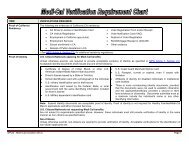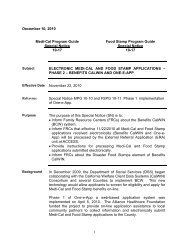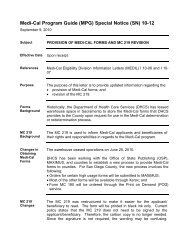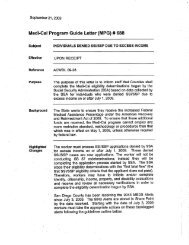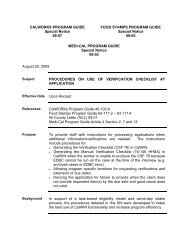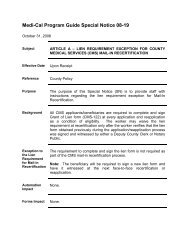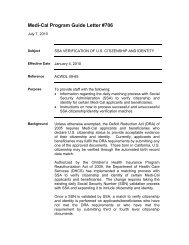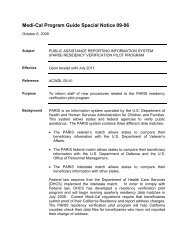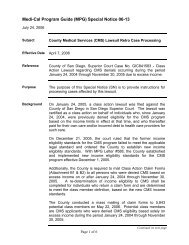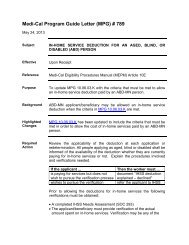CalFresh Special Notice 13-02 - HHSA Program Guides
CalFresh Special Notice 13-02 - HHSA Program Guides
CalFresh Special Notice 13-02 - HHSA Program Guides
You also want an ePaper? Increase the reach of your titles
YUMPU automatically turns print PDFs into web optimized ePapers that Google loves.
March 26, 20<strong>13</strong>CALFRESH PROGRAM GUIDE<strong>Special</strong> <strong>Notice</strong><strong>13</strong>-<strong>02</strong>Subject IMPLEMENTATION OF THE ANNUAL REPORTING/CHILD ONLY(AR/CO) SYSTEMReference All County Letter 12-49 and 12-49EEffective Date October 1, 2012PurposeTo provide information and instructions regarding the implementationof annual reporting provisions in the <strong>CalFresh</strong> program for AnnualReporting/Child-Only (AR/CO) CalWORKs cases receiving <strong>CalFresh</strong>.These instructions are aligned with preliminary instructions which wereissued on 9/28/<strong>13</strong>.Policy Change Until further notice, <strong>CalFresh</strong> households associated withCalWORKs AR/CO (<strong>CalFresh</strong> AR/CO) cases will be assigned ChangeReporting status. These households will:Not be required to submit a QR 7; they are required to reportchanges mandated by existing Change Reporting regulations.Refer to Section 63-261.2;Have their benefits calculated using prospective budgeting andreasonable anticipated income rules. Refer to Sections 63-252.2-5;Be assigned a certification period of 6 months when ahousehold member has earned income.<strong>CalFresh</strong> AR/CO cases in which all adult members are elderlyor disabled and have no earned income will be certified for 24months, the maximum amount allowed by federal regulations.<strong>CalFresh</strong> AR/CO Change Reporting cases will convert to Semi-AnnualReporting (SAR) when SAR is implemented.BackgroundCalifornia Senate Bill (SB) 1041 mandated the implementation of anannual reporting (AR) system for certain CalWORKs cases thatinclude no eligible adult in the Assistance Unit (AU). Generally, if alladults in a case are ineligible for or otherwise not receiving CalWORKsthemselves, the case will be an AR/CO case.Continued on next page<strong>CalFresh</strong> <strong>Special</strong> <strong>Notice</strong> <strong>13</strong>-<strong>02</strong>, Implementation of AR/CO Page 1
Background(continued)The following cases are considered AR/CO:All adults have timed out (i.e., Safety Net case);The adult(s) is excluded from the AU because of a disqualifyingdrug felony conviction, fleeing felon status, or has been foundby a court to be in violation of probation or parole;The adult(s) does not qualify for CalWORKs due to immigrationstatus;The adult(s) does not qualify because of failure to provide SSN;The adult(s) is receiving Supplemental Security Income (SSI);The adult(s) is a Non-Needy Caretaker Relative (NNCR);The adult(s) is sanctioned due to refusal to assign child/spousalsupport rights;The adult(s) has been convicted of an Intentional <strong>Program</strong>Violation (IPV) prior to July 1998; orThe adult(s) is a striker pursuant to Manual of Policies andProcedures (MPP) Section 44-206.1(b) and ineligible forCalWORKs for him/herself.In general, if there is no aided adult in the AU, the case is an AR/COcase. The following are non-AR/CO cases scenarios:Cases where the adult(s) is not aided due to welfare- to-work(WTW) sanction;Cases that are subject to a penalty, unless there is no adult inthe AU.SB 1041 also requires the implementation of annual reportingprovisions in <strong>CalFresh</strong> for CalWORKs AR/CO cases also receiving<strong>CalFresh</strong> benefits.AR/CO <strong>CalFresh</strong>HouseholdsCertificationRequirements<strong>CalFresh</strong> households associated with a CalWORKs AR/CO case willbe assigned the following certification periods:# of Months <strong>CalFresh</strong> AR/CO household with:6 Earned income12 No earned income24 No earned income when all <strong>CalFresh</strong> adult householdmembers are elderly or disabledNOTE: AR/CO <strong>CalFresh</strong> households with earned income thatpreviously had a 12-month certification period will be certified for 6months at the next recertification.Continued on next page<strong>CalFresh</strong> <strong>Special</strong> <strong>Notice</strong> <strong>13</strong>-<strong>02</strong>, Implementation of AR/CO Page 2
AR/CO <strong>CalFresh</strong>HouseholdsCertificationRequirements(continued)All regulations pertaining to recertification as specified in Section 63-304 apply to AR/CO <strong>CalFresh</strong> cases.AR/CO CALFRESH CASES CERTIFIED FOR 24 MONTHSAn annual redetermination is still required for the CalWORKs portion ofthe CalWORKs AR/CO/<strong>CalFresh</strong> case.When the assistance unit/household does not comply with theCalWORKs redetermination and the CalWORKs case isdiscontinued, the <strong>CalFresh</strong> household will receive Transitional<strong>CalFresh</strong> benefits.The worker will consider the CalWORKs redetermination tosatisfy the mandatory interim contact for households certified for24 months (Section 63-301.5). The <strong>CalFresh</strong> household is notrequired to submit any application forms at 12 months.AR/CO <strong>CalFresh</strong>HouseholdsReportingRequirementsAR/CO <strong>CalFresh</strong> households are required to report as mandated byexisting Change Reporting rules (Refer to Section 63-261). As setforth in Section 63-261, these households must report the followingchanges within 10 days from when the change becomes known: Changes in the source of income (starting, stopping, or changinga job); Earned income changes of more than $100 per month; Unearned income changes of more than $50 (except CalWORKs,General Relief, or Social Security Cost of Living Adjustments(COLAs)); Changes in household composition; Address changes and resulting change in shelter expenses; A change in the amount of child support payments made to anon-household member as specified in Section 63-224.15, and/ora change in the legal obligation to pay child support; and For able bodied adults without dependents (ABAWDs), areduction of work effort to less than 20 hours per week, oraveraging less than 80 hours per month, for purposes ofdetermining whether the ABAWD has satisfied the workrequirementNOTE: The United States Department of Agriculture (USDA) hasapproved a statewide waiver of the ABAWD work requirementand time limit for California. Refer to Section 63-160.3.Continued on next page<strong>CalFresh</strong> <strong>Special</strong> <strong>Notice</strong> <strong>13</strong>-<strong>02</strong>, Implementation of AR/CO Page 3
AR/CO <strong>CalFresh</strong>HouseholdsReportingRequirements(continued)Additionally, AR/CO <strong>CalFresh</strong> households are also required to reportthe following changes: Any member of the household who is avoiding or running fromthe law to avoid any felony prosecution, custody or confinementafter conviction, or who is found by a court to be in violation ofprobation or parole; Any household member who is convicted of a disqualifying drugrelatedfelony after August 22, 1996, for the manufacture, sale, ordistribution of a controlled substance(s), or for any activity inconnection with these unlawful acts, or harvesting, cultivating orprocessing marijuana, or involving a minor in the above activities.Change may be reported by telephone, personal contact, or mail usingeither the AR 3, the DFA 377.5, or letter and may be reported by ahousehold member, the household's authorized representative, or anyperson having knowledge of the household's circumstances.Note: Household members/AR’s reporting changes are NOT requiredto use form AR 3 or DFA 377.5.CALWORKs REPORTING REQUIREMENTSCalWORKs AR/CO Assistance Units (AUs) are mandated to reportchanges as set forth in CalWORKs <strong>Program</strong> Guide (CPG) Section 44-260-D.Action onReportedChangesAR/CO <strong>CalFresh</strong> households are required to report <strong>CalFresh</strong>mandatory changes within 10 days from when the change becomesknown. Benefits will be increased or decreased during the certificationperiod based on these changes.When a <strong>CalFresh</strong> mandatory change is reported, the worker will takeaction for <strong>CalFresh</strong>, but will consider the change a voluntary report forCalWORKs and will not take action to change the CalWORKs grantunless the new information results in an increase of CalWORKsbenefits. Per AR/CO regulations, the worker will not decrease ordiscontinue the CalWORKs grant/case mid-year unless the change ismandated to be reported for CalWORKs or it is a county-initiatedaction. Refer to CPG Section 44-260-F.CALWORKS VOLUNTARY REPORTSIn some cases, CalWORKs voluntarily reported changes may result inan increase in benefits for one program, while decreasing benefits forthe other program. For example, an increase in CalWORKs couldresult in a decrease in <strong>CalFresh</strong> benefits.Continued on next page<strong>CalFresh</strong> <strong>Special</strong> <strong>Notice</strong> <strong>13</strong>-<strong>02</strong>, Implementation of AR/CO Page 4
Action onReportedChanges(continued)The effective date for increases in <strong>CalFresh</strong> allotments will beno later than the month following the month in which the changeis reported. Refer to Section 63-262.2.<strong>CalFresh</strong> benefits will be decreased with timely and adequatenotice the month following the date the change was reported.Refer to Section 63-262.3.Example: A CalWORKs AR/CO case receiving <strong>CalFresh</strong> has aRedetermination/Recertification due in November 20<strong>13</strong>. In April 20<strong>13</strong>,the recipient voluntarily reports a $110 increase in earned income,which is not over the CalWORKs IRT.For CalWORKs, the worker may not take any action based onthis voluntary report and must issue a No-Change <strong>Notice</strong> ofAction (NOA).For <strong>CalFresh</strong>, the worker will update the budget and decreasebenefits effective the following month with timely notice.CALWORKS INCOME REPORTING THRESHOLD (IRT)CalWORKs recipients subject to AR/CO must report verbally or inwriting within 10 days when their income exceeds the IRT for their AUsize even if the income is received mid-year. A CalWORKs case withincome exceeding the IRT in AR/CO will be discontinued or thebenefits can be decreased the first day of the month following timelyand adequate notice.If CalWORKs benefits are decreased or discontinued due to theCalWORKs IRT, the worker will also act to determine the impact to the<strong>CalFresh</strong> household benefits. If the CalWORKs AR/CO case isdiscontinued, the worker will discontinue <strong>CalFresh</strong> and issueTransitional <strong>CalFresh</strong> benefits in accordance with Section 63-321.Example 1: Decrease in BenefitsAn AR/CO AU receiving <strong>CalFresh</strong> reports mid-year that the income isover the IRT. The AU anticipates this income will continue andprovides verification.The worker determines the case is still eligible for CalWORKs and<strong>CalFresh</strong>, but with a decreased benefit amount. Therefore, benefitswill be decreased for the remainder of the AR/CO period effective thefirst of the following month with timely notice. The reduced CalWORKsbenefits will also be used to determine the household’s <strong>CalFresh</strong>allotment for the following months in accordance with ChangeReporting budgeting rules.Continued on next page<strong>CalFresh</strong> <strong>Special</strong> <strong>Notice</strong> <strong>13</strong>-<strong>02</strong>, Implementation of AR/CO Page 5
Action onReportedChanges(continued)Example 2: No Change in BenefitsAn AR/CO AU receiving <strong>CalFresh</strong> reports mid-year that their combinedearned and unearned income is now over the IRT. The verificationprovided by the household indicates that the income increase is onlyfor the current month and will not continue; beginning next month thetotal income will be the same as before and below the IRT. Theworker will not take any action for the CalWORKs or <strong>CalFresh</strong> otherthan to provide the AU with a No Change NOA.Example 3: Discontinuance of CalWORKs AR/CO CaseAn AR/CO case has a Redetermination/Recertification due inNovember. The timed-out mother reports on July 15 that her incomeis over IRT and anticipates that her income will continue at this level.The worker determines the income is sufficient to render the AUineligible for CalWORKs. Therefore the worker discontinuesCalWORKs (and <strong>CalFresh</strong>) effective July 31 st with timely andadequate notice. Another notice is sent informing the household thatTransitional <strong>CalFresh</strong> will begin August 1 st .If the AU reports before the case is actually discontinued on July 31that the income has decreased and can no longer be reasonablyanticipated to continue, CalWORKs will be rescinded. The worker willdiscontinue the Transitional <strong>CalFresh</strong> case at the end of the month inwhich timely and adequate notice can be provided and issue PublicAssistance <strong>CalFresh</strong> benefits the following month.Example 4: Income over IRTAn AR/CO case has a Redetermination/Recertification due inSeptember. On September 3, before the interview, the AU reports thather income is over IRT and will continue at that level. The worker willuse the reported income to determine eligibility and the benefit amountfor the following 12-month AR/CO period, October through September.If the CalWORKs case is not discontinued due to the IRT report,the worker will calculate cash aid and <strong>CalFresh</strong> benefits takingthe reported income into account.If the IRT report is verified, the worker will not require thehousehold to verify this information again during theredetermination interview.If the CalWORKs case is discontinued, the worker will issuetimely notice to discontinue CalWORKs and regular <strong>CalFresh</strong>on September 30 th . Transitional <strong>CalFresh</strong> would be issuedeffective October 1 st .Continued on next page<strong>CalFresh</strong> <strong>Special</strong> <strong>Notice</strong> <strong>13</strong>-<strong>02</strong>, Implementation of AR/CO Page 6
Action onReportedChanges(continued)VOLUNTARY REQUESTS FOR DISCONTINUANCEHouseholds may voluntarily request to discontinue a householdmember or the entire CalWORKs and/or <strong>CalFresh</strong> case at any time.For <strong>CalFresh</strong>, a timely NOA is not required if the householdvoluntarily requests discontinuance in writing or in the presenceof a worker (Section 63-303.<strong>13</strong>).For CalWORKs, a notice is not required if the request is inwriting.ProspectiveBudgetingChange Reporting household eligibility is determined by usingprospective budgeting methodology. Prospective budgeting requiresthe worker to use income that the applicant or recipient anticipateswith reasonable certainty will be received in the upcoming certificationperiod or the remainder of the certification period.Current income information obtained at application or redetermination,as well as any reasonably anticipated changes in income will be usedas an indicator of the income that is anticipated to be available to thehousehold for the remainder of the certification period. Changes inincome reported mid-year will be evaluated using the current month’sincome in conjunction with any anticipated changes.NOTE: If the amount of income that will be received or when it will bereceived is uncertain, the worker will not count the portion of thehousehold's income that is uncertain.It is critical that workers thoroughly document how they arrived at theprojected income amount to calculate or determine benefits. Casecomments and other documentation will be particularly critical whendocumenting any changes in income, including, but not limited to: newincome, income that is ending, income that is expected to change,income that fluctuates (including anomalies such as overtime ormissed work), and income that is so unstable that the recipient cannotmake a reasonable estimate of what income to expect in futuremonths.EXCEPTION TO PROSPECTIVE BUDGETINGThe only exception to prospective budgeting is for <strong>CalFresh</strong>households, who by contract or self-employment derive their income ina period of time shorter than one year. The households will have thatincome averaged over the 12-month certification period, provided theincome from the contract is not received on an hourly or pieceworkbasis.<strong>CalFresh</strong> <strong>Special</strong> <strong>Notice</strong> <strong>13</strong>-<strong>02</strong>, Implementation of AR/CO Page 7
ReasonablyAnticipatedIncomeThe income reported at application and recertification will beconsidered reasonably anticipated and will be used in the budgetcalculation unless the recipient reports that they anticipate a change inthe upcoming certification period. Refer to Section 63-252.2.NEW INCOMEIf a household anticipates receipt of income from a new source in theupcoming certification period such as a new job or unemploymentinsurance benefits (UIB), the income will only be consideredreasonably anticipated if the worker determines that:1. The household has verified that the income has been approvedor authorized for the upcoming certification period or thehousehold is otherwise reasonably certain that the income willbe received within the certification period; and2. The anticipated amount is known and verified or the householdis otherwise reasonably certain of the amount of the income;and3. The start date of the income is known and verified or thehousehold is otherwise reasonably certain of the start date ofthe income.If a household anticipates receipt of new income in the upcomingcertification period but does not have reasonable certainty of the datesand amounts expected to be received, this income cannot beconsidered reasonably anticipated and therefore will not be used indetermining the benefits for the upcoming certification period.FLUCTUATING INCOMEIf the household’s monthly income fluctuates or they expect theincome reported on the Statement of Facts to change in the upcomingcertification period, the worker must attempt to find out the amount ofincome the household reasonably expects to receive in order todetermine what income, if any, can be reasonably anticipated for thenext certification period’s benefit calculation. Only the portion ofincome that the household reasonably anticipates it will receive can beused in the benefit calculation. If the recipient states that the income:Reported on the Statement of Facts is not typical, explains why,and lists an estimate of future income; barring any informationto the contrary, the recipient’s estimate of future income shouldbe used to determine the household’s benefit amount.Continued on next page<strong>CalFresh</strong> <strong>Special</strong> <strong>Notice</strong> <strong>13</strong>-<strong>02</strong>, Implementation of AR/CO Page 8
ReasonablyAnticipatedIncome(continued)Fluctuates so much that they can’t anticipate any income, noincome will be counted in the benefit calculation. If the workerdisagrees that the income is too unpredictable to anticipate, itmust explore with the applicant or recipient what amount, if any,can be reasonably anticipated and used in the budget andthoroughly document the basis for the amount used in the casenarrative.Example: A household has fluctuating income, but agrees that sheusually makes at least a minimum of $200 per month. The minimumanticipated income can be anticipated and used in the benefitcalculation. If the household cannot anticipate an amount or it isuncertain she will get paid in the upcoming certification period, then noincome can be reasonably anticipated or used in the benefitscalculation.CONVERSION FACTORSAs with QR, whenever a full month’s income is anticipated but isreceived on a weekly or bi-weekly basis the income will be convertedto a monthly amount by multiplying weekly amounts by 4.33 and biweeklyamounts by 2.167.Each paycheck does not need to be the same amount; however, thehousehold must reasonably anticipate that their monthly income willcontinue in order to convert the income into a monthly average. Incontrast, if the household receives weekly or bi-weekly paychecks buttheir income fluctuates month to month and they cannot reasonablyanticipate what their income will be, the conversion factor will not beused.AVERAGING INCOMEIn cases where the receipt of income is reasonably certain but themonthly amount may fluctuate, the household may elect to averagethe income over the 12-month certification period.When averaging income, the worker will budget the household’santicipated income fluctuations over the certification period. Anaverage must be recalculated at recertification and during thecertification period when the household reports changes.Households, who by contract or self-employment derive their incomein a period of time shorter than one year MUST have that incomeaveraged over the 12-month certification period, provided the incomefrom the contract is not received on an hourly or piecework basis.Continued on next page<strong>CalFresh</strong> <strong>Special</strong> <strong>Notice</strong> <strong>13</strong>-<strong>02</strong>, Implementation of AR/CO Page 9
ReasonablyAnticipatedIncome(continued)If the household chooses, income that is starting or ending mid-yearwill not be averaged over every month of the certification period.Income that the recipient anticipates will begin or end in one of themonths of the upcoming certification period will only be counted in themonths that the income is reasonably anticipated to be received.Note: Conversion of income received weekly or biweekly does notconstitute averaging.BudgetingIncomeExamplesExample 1: Income AveragedA CalWORKs AR/CO AU member receiving <strong>CalFresh</strong> works at aschool cafeteria from mid-September to mid-June. During the JulyRenewal/Recertification, the client reports that her job ended mid-June.A review of the employment history shows that the client always has abreak in employment during the summer months. Therefore, theworker will clarify if the job with the school will continue the followingSeptember. If the client does expect her job to resume in September,the income she receives from September through June must be addedand divided by 12 in order to come up with an average monthlyincome for the certification period. (e.g., She receives $400 inSeptember and June and $800 from October through May. Theaverage monthly income for the 12-month certification period will be:$7,200 divided by 12 = $600 per month).Example 2: Fluctuating IncomeDuring redetermination/recertification, a CalWORKs AR/CO AUreports and verifies current income of $300 per month, which changes(fluctuates) from month to month. The client reports she may receive$350 one month and $275 another month and there is no way topredict how much she will earn any given month. However, the clientagrees that she typically earns $300 per month.Based on this information the worker will budget $300 per month, forthe certification period since this reflects what can be reasonablyanticipated. The worker will clearly document in Case Comments howthis anticipated income amount has been determined.Reminder: The household may voluntarily report a decrease inincome at any time and the worker would issue a supplement whenappropriate.Continued on next page<strong>CalFresh</strong> <strong>Special</strong> <strong>Notice</strong> <strong>13</strong>-<strong>02</strong>, Implementation of AR/CO Page 10
BudgetingIncomeExamples(continued)Example 3: New Future IncomeDuring the September redetermination/recertification, a CalWORKsAR/CO AU reports no current income but reasonably anticipates andprovides verification that she will start a new job in November and willreceive $500 per month starting in December and ongoing. In thisinstance, the worker will not average the income. Instead, the workerwill not count the income for September-November and will budget the$500 starting in December (December through September). Theworker will issue timely and adequate notice to decrease benefits inDecember.Example 4: New Income over CalWORKs IRTDuring the February redetermination/recertification, a CalWORKsAR/CO AU reports and verifies that current income is over theCalWORKs IRT, which results in the case being discontinued. Theclient reports and provides verification she will be laid off four monthslater in June. The worker will discontinue CalWORKs and <strong>CalFresh</strong> atthe end of February with timely and adequate notice because theincome over IRT will last more than one month, issue Transitional<strong>CalFresh</strong> the following month, and advise the client to re-apply forCalWORKs in June.Example 5: Conversion FactorA CalWORKs AR/CO AU receiving <strong>CalFresh</strong> reports and verifies biweeklyearnings of $150 and $250, which is reasonably anticipated tocontinue for the remainder of the certification period. The worker willconvert the bi-weekly income to a monthly amount by adding the twobi-weekly checks, dividing by two, and applying the conversion factor:$150 + $250 = $400. $400/2 = $200. $200 X 2.167 = $433.40.$433.40 will be used as the average monthly income amount in thebudget.Example 6: Unstable IncomeDuring the annual redetermination/recertification, a CalWORKs AR/COAU reports and verifies current weekly income of $150, $200, and $75.The household reports the income varies from month to month andcannot be reasonably anticipated for future months.The worker will obtain additional clarification to determine if there is aminimum amount that the client can anticipate for future months.If unable to establish a minimum amount, the weekly conversionfactor cannot be used.If a minimum amount can be determined, the worker will use theconversion factor (4.33).The worker will document in Case Comments why and how themonthly income amounts were used in the final budget calculation.Continued on next page<strong>CalFresh</strong> <strong>Special</strong> <strong>Notice</strong> <strong>13</strong>-<strong>02</strong>, Implementation of AR/CO Page 11
BudgetingIncomeExamples(continued)Example 7:At the February CalWORKs AR/CO redetermination/recertification, theAU reports that their current income is $300/month from a part-timejob. The client anticipates that this income will continue and theverification provided indicates that the income amounts will graduallyincrease over the next year as follows:$300 from March through July;$400 from August through October; and$500 from November through February.For CalWORKs, rather than averaging the income to get onemonthly income amount to use over the new 12-month AR/COperiod, the worker will use the actual income amount that isreasonably anticipated.This will result in different grant amounts for Months 1-5 (March-July), Months 6-8 (August-October), and Months 9-12(November-February).For <strong>CalFresh</strong>, budget the income the same way as CalWORKs.Cases Movingbetween AR/COand QRUnder certain circumstances, a CalWORKs case will transitionbetween AR/CO and Quarterly Reporting. Consequently, theassociated <strong>CalFresh</strong> case will also transition between ChangeReporting and Quarterly Reporting unless the <strong>CalFresh</strong> household isChange Reporting (e.g., homeless, all adults are elderly or disabled,etc.). The following rules apply when a Change Reporting <strong>CalFresh</strong>household transitions between Change Reporting and QuarterlyReporting:1. The worker will change the status of households who transitionfrom Change Reporting to Quarterly Reporting beginning withthe first day of the month following the change in householdstatus.2. The case will continue to have the same reporting cycle andrecertification date the case had prior to becoming AR/COChange Reporting.Example:An AR/CO AU consists of a timed-out mother and her minorchild. The timed-out mother is added back to the CalWORKsAU June 1 st . In this case:Continued on next page<strong>CalFresh</strong> <strong>Special</strong> <strong>Notice</strong> <strong>13</strong>-<strong>02</strong>, Implementation of AR/CO Page 12
Cases Movingbetween AR/COand QR(continued)o If the next Redetermination/Recertification is November,the QR 7 will be due in August, which is the first QRperiod after the June change.o If the Redetermination/Recertification is December, theQR 7 will be due in September.3. The worker will not require the household to submit a QR 7 forany month in which the household was subject to ChangeReporting requirements.4. When a household transitions from Change Reporting toQuarterly Reporting, the worker will explain Quarterly Reportingrequirements to the household as described in 63-272.7, 63-115.3, and 63-115.2(B)(12) and (14).5. For households transitioning from Quarterly Reporting toChange Reporting, the worker will explain Change Reportingrequirement to the household as described in 63-261 within 10days of the date the household becomes exempt from QuarterlyReporting.NOTE: Change in reporting status for CalWORKs AR/CO cases willnot always impact the associated <strong>CalFresh</strong> cases because somehouseholds would have Change Reporting status regardless of AR/CO(e.g., the household is homeless, etc.).OverissuancesA <strong>CalFresh</strong> overissuance (claim) will be established based on recipientfailure to report accurately and completely (Inadvertent HouseholdError) and worker error (Administrative Error).ADMINISTRATIVE ERROR (AE)An AE claim will be established when the worker fails to act timely on areported change or applies the change incorrectly. The firstoverissuance month will be the first month that the worker would havemade the change subject to the ten-day notice requirement.INADVERTENT HOUSEHOLD ERROR (IHE)For CalWORKs, an overpayment is required to be assessed for anymonth in which a higher benefit amount is issued because timelynotice could not be given.Continued on next page<strong>CalFresh</strong> <strong>Special</strong> <strong>Notice</strong> <strong>13</strong>-<strong>02</strong>, Implementation of AR/CO Page <strong>13</strong>
Overissuances(continued)For <strong>CalFresh</strong> Change Reporting households, a claim will beestablished if the household fails to report a change within 10 days ofthe date the change became known. The first overissuance month willbe the first month in which the change would have been effective if ithad been reported timely.An overissuance will not be assessed if the household reports thechange timely, within 10 days of the date the change occurred, andthe worker is unable to decrease benefits because of timely (10-day)notice requirements.Example: An AR/CO case has a redetermination/certification period ofJune-May. On September 15, a household member receives incomein excess of the CalWORKs IRT and the <strong>CalFresh</strong> Change Reportingearned income reporting requirements. The mother fails to report theincrease in income until November 5.The increased income is not enough to discontinue the case. Theworker will reduce the CalWORKs grant and <strong>CalFresh</strong> allotmenteffective December 1 st with timely and adequate notice and willestablish an overpayment/overissuance claim as follows:CalWORKs: A claim will be established for October andNovember because the change occurred in September and hadthe household reported the change within 10 days, the workerwould have decreased her benefits effective October 1 st .<strong>CalFresh</strong>: A claim will be established only for Novemberbecause the worker would not have been able to decreasebenefits effective October due to timely-notice requirements(Change Reporting households must be allowed 10 days toreport a change and in this case the household had untilSeptember 25 to report the change).Refer to Sections 63-451, 63-452, and 63-454.AutomationImpactPlease refer to the Automation Impact section of CPG Letter #284.ClientCorrespondencePlease refer to the Correspondence & Document Capture Impactsection of CPG Letter #284.DocumentProcessingCenter (DPC)ImpactPlease refer to the Document Processing Center (DPC) Impact sectionof CPG Letter #284.<strong>CalFresh</strong> <strong>Special</strong> <strong>Notice</strong> <strong>13</strong>-<strong>02</strong>, Implementation of AR/CO Page 14
ACCESS Impact Please, refer to the ACCESS Impact section of CPG Letter #284.OperationalImpactPlease refer to the Operational Impact section of CPG Letter #284.Quality ControlImpactQuality Control will cite the appropriate error when instructions in this<strong>CalFresh</strong> <strong>Special</strong> <strong>Notice</strong> are not followed or are followed incorrectly.DirectorApprovalRICK WANNE, MA, MFTEligibility Operations DirectorOA<strong>CalFresh</strong> <strong>Special</strong> <strong>Notice</strong> <strong>13</strong>-<strong>02</strong>, Implementation of AR/CO Page 15



